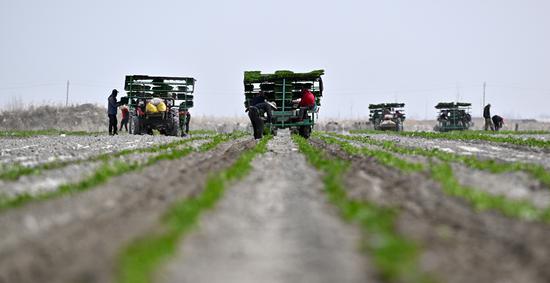Living in a remote village in northwest China, Liang Weiguo, 76, never thought he would be able to receive medical services at home by making a simple phone call.
Thanks to a family-doctor service system in his area, Liang is no longer anxious about his old age, despite having multiple health conditions including hypertension and prostatic hyperplasia.
"I couldn't have imagined 10 years ago that I could call someone on the phone and see a doctor at home," Liang said.
It used to take at least a day to go and see a doctor, he said, but now there is no need to travel far, and the cost of medication is much lower.
As an important part of rural public healthcare services, the family-doctor service has been basically realized in all city and county-level places in China. More than 420,000 family-doctor teams have provided medical and health services, including long-term prescription and on-site services.
For this year's World Health Day, which fell on April 7, China set a domestic theme of "channeling quality medical resources down to the community level to ensure health for all," which aims to facilitate people's convenient access to health services.
Receiving medical services used to be difficult for many Chinese people living in isolated areas. However, due to the government's strenuous efforts at different levels in the country, things are very different now.
At a medical facility on a small island in east China's Zhejiang Province, a pair of glasses with 5G and AR technologies have enabled people like Liang to receive diagnosis and treatment from doctors based in big cities.
Furthermore, in some parts of the country, medical experts from higher-level hospitals have been dispatched and stationed in township hospitals to provide medical services for locals.
"When we meet difficulties in treatment, the higher-level hospitals can not only provide remote guidance but also make home visits or arrange transfers to ensure that every villager can receive effective treatment," said Liu Wenju, a village doctor in Xiema Village, southwest China's Chongqing Municipality.
At present, there is still an imbalance in the allocation of medical resources between urban and rural areas in the country, and the vast rural areas are a weak link in China's public health system.
To improve the situation, the country has introduced a slew of measures as policy support. China is also optimizing the allocation of resources, strengthening rural health service capacity, and expanding the supply of high-quality medical resources by selecting and setting up new national medical centers and regional medical centers.
In late February, the Chinese authorities issued a set of guidelines to promote the sound development of the medical and health system in the country's rural areas.
The document stressed the importance of building a high-quality and efficient rural medical and healthcare system suited to the countryside, so that residents can enjoy access to fairer and more systematic medical services in their vicinity.
By the end of 2021, China had 23,000 county-level medical institutions, 35,000 township hospitals, and 599,000 village clinics.
"From government measures to the practice of local hospitals, the flexibility and resilience of medical treatment resources and the public health system will be further promoted, and people will have a greater sense of gain in receiving medical services," said Qiu Jie, director of Gansu provincial central hospital.


















































 京公网安备 11010202009201号
京公网安备 11010202009201号